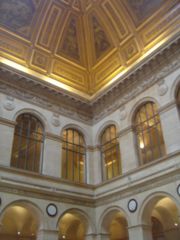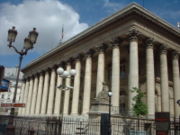巴黎證券交易所
出自 MBA智库百科(https://wiki.mbalib.com/)
巴黎證券交易所(Paris Bourse/Paris Stock Exchange)
目錄 |
巴黎證券交易所是法國最大的證券交易所,1724年正式建立,其經紀人由法國財政經濟部指定,共有99人,其中巴黎71人,外省28人。證券經紀人的工作是接受客戶買賣證券的委托,掌握買賣雙方供求數量和要求的價格幅度,代客戶進行買賣,從中收取佣金。
巴黎證券交易所內的證券價格由供求關係決定,官方牌價由交易所業務委員會聽取經紀人同業公會的意見後公佈。
法國從1961年開始,所有交易所實行“單一價格”。巴黎證券交易所發行全國性、國際性和外國證券,7家外省交易所經營地區證券買賣、並劃分了各自的管轄區,但有時一種證券也同時在幾個交易所買賣,標價統一。巴黎所買賣的證券,在官方牌價表上約有經濟部門的1300個發行者,其中180多個來自外國。交易所的客戶是證券持有者,除其本國法人如保險公司、退休金金庫、存款及信托金庫、可變資本投資公司、共同投資基金、銀行、工業發展局和地區發展公司外,外國人(含外國企業)也持有各種證券。交易所在進行現貨交易的同時也進行期貨交易,期貨交易的絕大部分在巴黎所進行。此外,不屬於官方牌價表上的一切證券可以進行場外交易,但只能是即期買賣。
巴黎證券交易所的組織機構包括:
- (1)經紀人公會,由法國7家交易所的經紀人組成,屬私人機構;
- (2)交易所業務委員會,1967年成立,系國家機構,主席由部長理事會任命,另加國庫司的一個成員作為政府特派員參加該委員會。其職責是對有關重大問題(如建立或撤銷交易所、修改現行法律章程)提出意見和建議,對一些技術性的問題作出決定。如確定期貨交易所需要的保證金數額、決定佣金費率;在征求同業公會的意見後,對准許證券列入官方牌價表或註銷上市的證券作出最後決定;向共和國總統遞交日報和年報。巴黎證券交易所在世界各大交易所中,次於紐約、東京和倫敦,名列第四。
巴黎證券交易所是法國唯一的全國性的證券交易所。長期以來,巴黎證交所,一直以債券交易為主。不過80年代以來,法國實行了一系列金融改革政策措施以後,巴黎證交所的股票和債券發行量大大增加。
巴黎證券交易所以往一直由法國財政部直接管理,1967年以後改由證券交易業務委員會管理。該委員會作為國家機構,對交易所的交易活動進行監督,並對重大問題作出決定。
1986年,巴黎證交所開辦了金融期貨市場,它以債券為主要對象,並從事長期和短期的所有金融商品的交易。自1991年5月起,巴黎證券市場的結算交割作業全部納入了電腦系統,交易效率得到了很大的提高。
Historically, stock trading activities have been located in several spots of the Parisian geography, including the rue Quincampoix, the rue Vivienne (near the Palais Royal), or the back of the Opéra Garnier (the Paris opera house). In the early nineteenth century, the Paris Bourse's activities found a stable location at the Palais Brongniart, or Palais de la Bourse (the building is due to architect Alexandre-Théodore Brongniart).
歷史上,證券交易活動位於巴黎地區若幹地點,包括, Quincampoix大街、Vivienne大街(臨近皇家花園)抑或是Garnier劇場。十九世紀初,巴黎證券交易所的活動有了固定場所:Brongniart宮殿,或者叫證券宮(建築命名源於建築師亞歷山大西奧多Brongniart)
From the second half of the nineteenth century, official stock markets in Paris were operated by the Compagnie des agents de change, directed by the elected members of a stockbrokers' syndical council. The number of participants in the processes of the formation of prices and of exchange in each of the different trading areas of the Bourse was limited. In the case of the agents de change (the official stockbrokers at the Paris Bourse), there were around 60. An agent de change had to be a French citizen, be nominated by a former agent or his estate, be approved by the Minister of Finance, and was appointed by decree of the President of the Republic. Officially, the agents de change could not trade for their own account nor therefore even be a counterpart to someone who wanted to buy or sell securities with their aid; they were strictly brokers, that is, intermediaries. In the financial literature, the Paris Bourse is hence referred to as "order-driven market", as oppose to "quote-driven markets" or "dealer markets", where price-setting is handled by a dealer or market-maker. In Paris, only agents de change could receive a commission, at a rate fixed by law, for acting as an intermediary.
自十九世紀下半葉開始,在股票經紀人聯合會代表的監督下,巴黎的官方證券交易所由股票經公司經營。證券交易所不同交易區域里,數量有限的參與者促成了交易和交易的價格。至於股票經紀人(指巴黎交易所的官方經紀人),其數量在60人左右。一個股票經紀人,應該為法國公民,由一位前經紀人提名,經財政部長批准後,由總統書面任命。明確規定,經紀人不能用自己的帳戶做交易,也還能成為在其幫助下有購買或出售證券意向者的交易對方;他們作為嚴格意義上的中介者。因此,在金融著作中,巴黎證券交易所被稱之為“指令驅動的市場”,與此相對應的是“報價驅動的市場”又稱“交易員市場”,後者的定價由交易員或做市商掌握。在巴黎,只有經紀人可以通過中介活動收取法定比例的佣金。
However, parallel arrangements were usual in order to favor some clients' quote. Moreover, until approximately the middle of the twentieth century, a parallel market known as "La Coulisse" was in operation.
Until the late 1980s, this market was operating as an open outcry exchange, with the "agents de change" (the Parisian stockbrokers) meeting in the exchange floor of the Palais Brongniart. In 1986, the Paris Bourse started implementing an electronic trading system known as CATS (Computer Assisted Trading System), renamed CAC (Cotation Assistée en Continu) for the Parisian version. By 1989, quotation was fully automated. The Palais Brongniart was then hosting the French financial derivatives exchanges MATIF and MONEP, until full automation of these in 1998. In the late 1990s, the Paris Bourse launched the Euronext initiative, which consisted in the alliance of several European stock exchanges.
On the history of the Paris Bourse:
Lehmann, P.-J. 1991 La Bourse de Paris, Paris: Dunod.
Lehmann, P.-J. 1997 Histoire de la Bourse de Paris, Paris: PUF.
Muniesa, F. 2005 "Contenir le marché: la transition de la criée à la cotation électronique à la Bourse de Paris", Sociologie du Travail 47(4): 485-501.
Walker, D. A. 2001 "A factual account of the functioning of the nineteenth-century Paris Bourse", European Journal of the History of Economic Thought 8(2): 186-207.
On the structure of the Paris Bourse:
Biais, B., Foucault, T. and Hillion, P. 1997 Microstructure des marchés financiers: institutions, modèles et tests empiriques, Paris: PUF.
Hamon, J. 1995 Marché d'actions: architecture et microstructure, Paris: Economica.
Hamon, J. and Jacquillat, B. 1992 Le marché français des actions: études empiriques 1977-1991, Paris: PUF.









